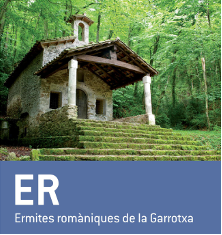In La Garrotxa there is an exceptional sample of the architectural legacy of the Middle Ages. Of all the places where this rich heritage is preserved, two generally stand out from all the rest: Besalú and Santa Pau.
The Royal Cúrial, the old Palace of Justice seat of the Vegueria and Royal Court; the old Monastery of Sant Pere, one of the most characteristic Romanesque temples in the country; Sant Vicenç, an example of the Romanesque harmony between construction and rustic surroundings; and the Old Bridge, fortified and angled, these are some of Besalú's most important Romanesque structures.
Santa Pau is La Garrotxa's other highlight from the Middle Ages. The castle, which is not open to the public, presides over the village, perfectly sealed and enclosed by an ancient wall. With its irregular shape and almost completely arcaded, the village's main square, overlooked by Santa Maria church, is not to be missed. The narrow and steep alleyways, the large windows, gateways and arches are Santa Pau's real attraction.
La Garrotxa's most notable monasteries are Sant Pere de Besalú, Sant Llorenç de Sous, Riudaura, Sant Ferriol and Sant Joan les Fonts, where the medieval castle Estada Juvinyà, a Romanesque building that houses the Territorial Interpretation Centre, is also located.
La Garrotxa has a large concentration of Romanesque churches, especially in the Alta Garrotxa and the Besalú area. The earthquakes of 1427 and 1433 severely affected the Olot area, destroying many buildings. Sant Joan de Balbs, situated at La Pinya, is a jewel; Santa Bàrbara de Pruneres preserves a splendid sepulchral gravestone; Santa Maria d'Escales perches on a cliff; Sant Martí de Toralles; Sant Miquel del Corb, beside the forest; Sant Andreu de Socarrats; Santa Eulàlia de Begudà and, finally, the basilica of Sant Sepulcre de Palera.
Beget, in Ripollès county, is the architectural jewel of La Garrotxa. Sant Cristòfol church is an example of Romanesque design in its purest form and it is among the most interesting in Catalonia. Unlike other places of worship, it has preserved its heritage which, as well as the Romanesque Majesty of Beget carving, consists of a Gothic altarpiece, an interesting baptism font and several Baroque altars.
A visit to La Garrotxa brings you into contact with this art that is as old as it is interesting, and harks back to Christianity's most austere period.
One of the most notable events in La Garrotxa's history was enacted by Francesc de Verntallat, who led the Remences uprising, a revolt of the peasantry against their feudal lords. The Remences were peasants that were unable to abandon their land. This was because they could not free themselves from the landlords' control or stop being subject to the abuses imposed on them (abusive feudal customs that led to the Remences War between 1460 and 1486) without paying an amount set by the lord, or face harsh punishment. Verntallat took up the struggle and ended up securing, through an agreement known as La Sentència Arbitral de Guadalupe, the abolition of the tax and the feudal abuses and injustices. Francesc de Verntallat came from La Vall d'en Bas, and this valley and that of Hostoles were the main stages of the peasants' revolt against the unfair system.
Nowadays, these valleys still preserve some remnants of that period, such as Hostoles castle and Puig-alder castle, and these can be visited via several routes.
With regard to sculpture, the most important work is Crist en Majestat, which is in Sant Joan les Fonts monastery. This piece - a reproduction, since the original is kept in Girona's Museu Diocesà - can be seen by arranging a visit through the Tourist Office.
Romanesque
Routes and excursions TOP
-

The Churches of el Corb route. Route 4 Les Preses
Sant Miquel del Corb and Sant Martí del Corb, two of the best-kept secrets of the Romanesque heritage of La Garrotxa.
-

Els Comuns. Route 1 Tortellà
The route takes us to the Comuns quarry, a stone extraction site that used to build the Olot motorway to Besalú. The mining activity was stopped in 2010 and is currently under restoration.
-
Modernist Garrotxa
Discover the Art Nouveau heritage of la Garrotxa.
-

Sant Miquel de Coma-de-Roure route
In a small pass between the Borró valley and the Espinau valley, stands the small church Sant Miquel de Coma-de-Roure, located on top of the mountain of the same name with magnificent views.
-

Parc de Pedra Tosca. Route Olot 4
This easy walk is perfect for the whole family. You pass along the Carrilet, the former train line to Girona that acts as a reminder of Olot’s rich industrial past. Further on you visit El Parc de Pedra Tosca.
-

Sant Feliu de Pallerols centre. Natural Park route 18
Urban itinerary that allows to know the medieval structure of the town, as it evolved from the houses of la Sagrera and the Romanesque church to the walled Cellera and the current town, and the most relevant elements of the historic centre.
-
Memories of the last Carlist War
This route visits some of the sites in La Garrotxa that are indelibly associated with the Third Carline War (1872–1876).
-

Circular route Mare de Déu del Mont Half Marathon (MdM)
High difficulty route, 20,6 KM and ascent of 1605 m
-

The Romanesque churches of Maià de Montcal and Beuda
Maià de Montcal and Beuda are both good examples of La Garrotxa’s valuable cultural heritage and their wonderful Romanesque churches are the perfect excuse to visit this part of La Garrotxa.
-

The Romanesque churches of La Vall de Bianya
The traces of the history of La Vall de Bianya can be followed in this itinerary that visits the 15 Romanesque churches that decorate this peaceful corner of La Garrotxa.












